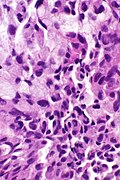Lung carcinoma with ALK rearrangement
(Redirected from ALK positive lung cancer)
Jump to navigation
Jump to search
Lung carcinoma with ALK rearrangement is subset of lung adenocarcinoma.
General
ALK (anaplastic lymphoma (receptor tyrosine) kinase):
- Approximately 1-5% non-small cell lung carcinoma.[1]
- Typically seen in nonsmokers and younger age patients.
- Can be treated with crizotinib.[2]
- Resistance to ALK inhibitors may occur due mutations in kinase domain.
- Ceritinib is indicated for tumor with acquired resistance to crizotinib.[3]
- Testing in FFPE tissue requires ~100 cells.[4]
Microscopic
Features:[1]
- Adenocarcinoma - at least focally.
- Solid signet-ring cell pattern - common.
- Mucinous cribriform pattern - common.
DDx:
Images
www
- Lung carcinoma with ALK rearrangement (nih.gov).[5]
- Lung carcinoma with ALK rearrangment (nih.gov)[6] - high resolution (plosone.org).
IHC
Features:[1]
- p63 +ve.
- TTF-1 +ve.
- ALK +ve.[citation needed]
Images
Molecular
- EML4-ALK fusion -- inv(2)(p21p23).[7]
- C-terminus of ALK protein fuses with N-terminus portion of partner protein.
- ALK fusion leads to ligand-independent constitutive activation of important pathways in oncogenesis and tumor progression.
- C-terminus of ALK protein fuses with N-terminus portion of partner protein.
Notes:
- May be demonstrated with FISH or PCR looking for the a fusion transcript.[8]
- ALK rearrangement does not occur with EGRF mutation or KRAS mutation.[8]
See also
References
- ↑ 1.0 1.1 1.2 Yoshida, A.; Tsuta, K.; Nakamura, H.; Kohno, T.; Takahashi, F.; Asamura, H.; Sekine, I.; Fukayama, M. et al. (Aug 2011). "Comprehensive histologic analysis of ALK-rearranged lung carcinomas.". Am J Surg Pathol 35 (8): 1226-34. doi:10.1097/PAS.0b013e3182233e06. PMID 21753699.
- ↑ Crystal, AS.; Shaw, AT. (Mar 2011). "New targets in advanced NSCLC: EML4-ALK.". Clin Adv Hematol Oncol 9 (3): 207-14. PMID 21475126.
- ↑ Shaw, AT.; Kim, DW.; Mehra, R.; Tan, DS.; Felip, E.; Chow, LQ.; Camidge, DR.; Vansteenkiste, J. et al. (Mar 2014). "Ceritinib in ALK-rearranged non-small-cell lung cancer.". N Engl J Med 370 (13): 1189-97. doi:10.1056/NEJMoa1311107. PMID 24670165.
- ↑ Popper, HH.; Tímár, J.; Ryska, A.; Olszewski, W. (Oct 2014). "Minimal requirements for the molecular testing of lung cancer.". Transl Lung Cancer Res 3 (5): 301-4. doi:10.3978/j.issn.2218-6751.2014.10.02. PMID 25806315.
- ↑ Lopes, LF.; Bacchi, CE. (Jul 2012). "Anaplastic lymphoma kinase gene rearrangement in non-small-cell lung cancer in a Brazilian population.". Clinics (Sao Paulo) 67 (7): 845-7. PMID 22892933.
- ↑ Takamochi, K.; Takeuchi, K.; Hayashi, T.; Oh, S.; Suzuki, K. (2013). "A rational diagnostic algorithm for the identification of ALK rearrangement in lung cancer: a comprehensive study of surgically treated Japanese patients.". PLoS One 8 (8): e69794. doi:10.1371/journal.pone.0069794. PMID 23936355.
- ↑ Li, Y.; Ye, X.; Liu, J.; Zha, J.; Pei, L. (Jan 2011). "Evaluation of EML4-ALK fusion proteins in non-small cell lung cancer using small molecule inhibitors.". Neoplasia 13 (1): 1-11. PMID 21245935.
- ↑ 8.0 8.1 Gainor, JF.; Varghese, AM.; Ou, SH.; Kabraji, S.; Awad, MM.; Katayama, R.; Pawlak, A.; Mino-Kenudson, M. et al. (Aug 2013). "ALK rearrangements are mutually exclusive with mutations in EGFR or KRAS: an analysis of 1,683 patients with non-small cell lung cancer.". Clin Cancer Res 19 (15): 4273-81. doi:10.1158/1078-0432.CCR-13-0318. PMID 23729361.










